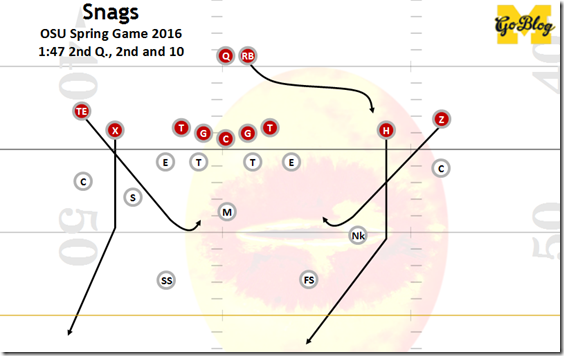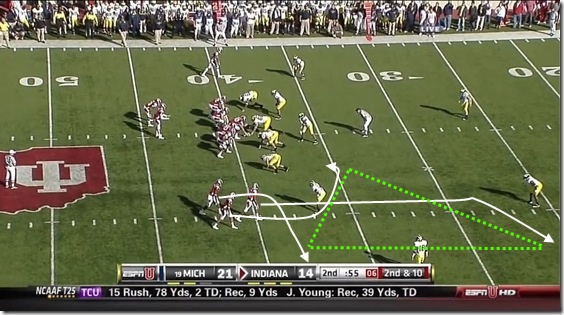The last few years Michigan moved toward becoming a major Cover 1 defense, and that looks to continue under Don Brown, whose BC teams were in a Cov1 (“City”) over half the time.
Last weekend I noticed more than a few opponents (and non-opponents) were practicing Cover 1 beaters in their spring games. So I thought I’d show one from Ohio State’s that I found particularly interesting. Hoping the coaches will chime in on this one since I’m not sure of everything I saw. Here’s the play:
It’s a snag package, a thing we talked about in the Borges days because it’s a good way to create those triangles that work against all coverages. Smart Football at that link:
The snag is so synonymous with the triangle concept that some teams simply call it “triangle.” The basic concept involves one receiver in the deep third on a corner route (good by itself against man-to-man), one receiver in the flat, often a runningback or inside receiver (which can also be good against man from a bunch-set), and a third receiver on the “snag” route, sometimes also known as a “slant-settle” or a “mini-curl.”
Building triangles is high up in the scale of offensive complication, because you’re asking the quarterback to ID the coverage and read multiple defenders.
However the first rule of Urban Meyer offenses is keep the thinking to a minimum* and lo and behold their snag isn’t really being run like a triangle. On this play Ohio State doesn’t even bother setting the high-low on the corner. Instead they set some picks on the outside to make it unlikely a CB will be able to cover the stick routes, draw off the rest of the coverage, and isolate the middle linebacker, giving the QB a simple read: See which way the MLB turns his hips, and throw behind him.
If that’s not open, find a guy going long and loft it. And if they’re not there, run around.
---------------------------
* [This is NOT a statement about the academic capability of Ohio State quarterbacks. Keeping things simple is a thing coaches try to do for all players, not just the intellectually incurious ones who’ve never heard of Uber.]
[Hit the jump to see how it works vs. man coverage]
You can see how it worked out against OSU’s kinda weird [it’s not very relevant to us but I covered it at the bottom*] zone coverage.
After everything got sorted out the MLB was responsible for inside help on the SAM’s guy (the Flex TE all the way on the left) and the Z receiver. The weirdness of OSU’s defensive playcall is helpful for our purposes because we get to see it work against Man and Zone on the same play.
On the bottom the SAM widens to prevent the X receiver from getting a freebie up the seam, then sees the slant route crossing beneath him and trails, expecting the MLB to be in the middle zone. On the top, the CB has that Z receiver in man coverage. That receiver runs his route too shallow so the pick doesn’t even work, but at best the CB is boxed out. The MLB, meanwhile was getting depth to cover the Z’s slant. By the point when the receivers curl back on the hashes, that MLB is in the middle of the Eye of Sauron. The TE is open, and Barrett, reading low-to-high, doesn’t have to come off his first read.
THEN HOW IS THIS A MAN-BEATER?
The picks.
The cornerbacks are first and foremost, you imagine, worried about staying over the top of their receivers. A slant is a bitch to cover to begin with, and then add all that traffic a half second before the throw. The CB in man on the top of the screen (Damon Webb) got off the hook thanks to the WR running a shorter route, but if the bottom CB was in man he’s got that inside receiver colliding with the SAM in his path.
Let’s imagine they’re playing Michigan’s base D.
The cornerbacks get rubbed off their man coverage by the picks set by the #2 receivers as they go vertical, and the releasing RB should carry the WLB out of the picture. Again you’ve got the MLB picking a side. The QB looks to whichever snag the MLB isn’t going to, and if that guy isn’t blanketed by a miraculously good CB or some weird coverage he throws it.
And if he’s covered (I mean, Jourdan Lewis is in there), it’s not another read; just find the guy running downfield with one defender on him. Meyer’s offense likes to send a couple guys at the safeties every play just to make sure those safeties aren’t coming down and wreaking havoc on the run game. When he has a freakishly dangerous long man that’s extremely effective. When he has a stable of downfield threats he can tire out your secondary in a hurry.
LESSONS
If I’m a Michigan opponent I’m planning on attacking the linebackers first. Chances are the DL will be good enough not to need too many blitzes or safety help to keep things down, and the secondary is so talented that favorable matchups will be hard to find. Attacking the LBs laterally seems like the thing to do.
---------------------------
* [On OSU’s defense this play: it threw me for a loop but I think it was “Penny 3” by which I mean the field cornerback has the Z receiver in man-to-man wherever he goes and the rest of the defense plays a 10-on-10 cover 3 that’s squished toward the boundary, meaning the boundary side are playing 1/4 zones while the field side the FS and the Nickel are playing 1/2 zones:
The SAM and Nickel are responsible for a quick seam or curl and then cover the flats if they’re threatened (the nickel’s flat is threatened by the RB). Basically it’s a vanilla cover 3 that ignores the Z receiver. I didn’t want to get into it too much because OSU’s spread coverages in the spring game are not very relevant to Michigan.]






